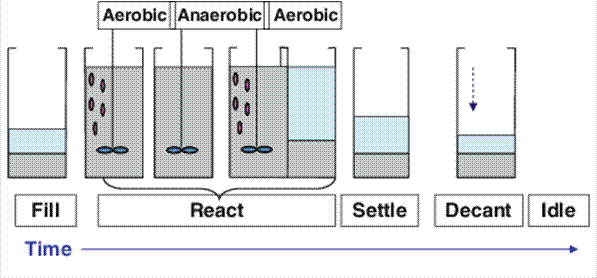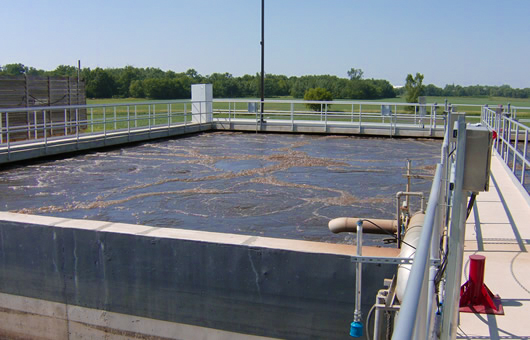The sequencing batch reactor (SBR) is a type of activated sludge process designed for the treatment of wastewater. This technology operates in a batch mode and is characterized by a series of sequential steps that include filling, reacting, settling, decanting, and idling. The SBR system is distinguished by its ability to perform equalization, aeration, and clarification within a single reactor, thereby optimizing the treatment process.

From an engineering standpoint, the SBR system is composed of one or more tanks that function as reactors. These reactors are equipped with various mechanical and electrical components that facilitate the different stages of the treatment process. The primary components of an SBR system include:
- Influent Pumping System: This system is responsible for delivering raw wastewater into the reactor. The influent pumping system is typically controlled by a programmable logic controller (PLC) to ensure precise timing and volume control.
- Aeration System: The aeration system consists of diffusers or mechanical aerators that introduce oxygen into the wastewater. This system is crucial for maintaining aerobic conditions, which are necessary for the biological degradation of organic matter.
- Mixing System: Mechanical mixers or recirculation pumps are used to ensure uniform distribution of the wastewater and activated sludge within the reactor. This promotes efficient contact between the microorganisms and the organic pollutants.
- Decanting System: The decanting system is designed to remove the treated effluent from the reactor after the settling phase. This system typically includes a floating or fixed decanter that minimizes the disturbance of the settled sludge.
- Control System: The control system, often a PLC, orchestrates the various stages of the SBR cycle. It regulates the timing and operation of the influent pumps, aeration system, mixers, and decanting system.
The SBR process is governed by a series of biochemical reactions that occur in distinct phases. These phases are designed to optimize the removal of organic matter, nitrogen, and phosphorus from the wastewater. The primary phases of the SBR process are as follows:
Fill Phase: During the fill phase, raw wastewater is introduced into the reactor. This phase can be conducted under anoxic or aerobic conditions, depending on the desired treatment objectives. Anoxic conditions are typically used for denitrification, while aerobic conditions promote the oxidation of organic matter.
React Phase: In the react phase, the wastewater is subjected to aeration and mixing. Oxygen is introduced into the reactor, facilitating the aerobic degradation of organic pollutants by microorganisms. The biochemical reactions that occur during this phase include the oxidation of organic matter to carbon dioxide and water, as well as the nitrification of ammonia to nitrate.
Settle Phase: The settling phase involves the cessation of aeration and mixing, allowing the biomass to settle to the bottom of the reactor. This phase is critical for the separation of the treated effluent from the activated sludge. The settling characteristics of the sludge are influenced by factors such as sludge age, biomass concentration, and the presence of filamentous bacteria.
Decant Phase: During the decant phase, the treated effluent is removed from the reactor. The decanting system is designed to minimize the disturbance of the settled sludge, ensuring that only the clarified effluent is discharged. The decanted effluent is typically subjected to further treatment or discharged to a receiving water body.
Idle Phase: The idle phase is a period of inactivity between the decant and fill phases. It allows for preparing the reactor for the next cycle and can be used for maintenance activities such as sludge wasting or equipment inspection.
Application in Water Treatment
The SBR technology is widely used in both municipal and industrial wastewater treatment applications. Its versatility and efficiency make it suitable for a variety of treatment scenarios. The key advantages of SBR technology in water treatment include:
Flexibility: The batch mode operation of SBR systems allows for greater flexibility in handling variations in influent flow and composition. This makes SBRs particularly well-suited for small to medium-sized treatment plants and facilities with fluctuating wastewater characteristics.
Compact Footprint: The integration of equalization, aeration, and clarification within a single reactor reduces the overall footprint of the treatment plant. This is particularly advantageous in urban areas where space is limited.
Enhanced Nutrient Removal: SBR systems can achieve high levels of nutrient removal, including nitrogen and phosphorus. The ability to control the timing and conditions of each phase allows for the optimization of biological nutrient removal processes.
Operational Simplicity: The automated control systems used in SBR technology simplify the operation and maintenance of the treatment plant. The PLC-based control systems can be programmed to adjust the cycle times and operational parameters based on real-time data, ensuring consistent treatment performance.
Cost-Effectiveness: The reduced need for multiple tanks and the ability to handle variable influent loads contribute to the cost-effectiveness of SBR systems. The lower capital and operational costs make SBR technology an attractive option for many wastewater treatment applications.
Improvement of Water Treatment Processes
The implementation of SBR technology has led to significant improvements in water treatment processes. The key areas of improvement include:
 Effluent Quality: The ability to achieve high levels of organic and nutrient removal results in superior effluent quality. This is particularly important for meeting stringent discharge standards and protecting receiving water bodies.
Process Stability: The batch mode operation and automated control systems enhance the stability and reliability of the treatment process. This reduces the risk of process upsets and ensures consistent treatment performance.
Energy Efficiency: The optimization of aeration and mixing processes in SBR systems contributes to energy savings. The ability to control the timing and intensity of aeration reduces the overall energy consumption of the treatment plant.
Scalability: SBR technology is scalable and can be adapted to a wide range of treatment capacities. This makes it suitable for both small-scale decentralized systems and large-scale municipal treatment plants.
Environmental Sustainability: The efficient removal of pollutants and nutrients from wastewater contributes to environmental sustainability. The treated effluent can be safely discharged or reused for various applications, reducing the demand for freshwater resources.
Effluent Quality: The ability to achieve high levels of organic and nutrient removal results in superior effluent quality. This is particularly important for meeting stringent discharge standards and protecting receiving water bodies.
Process Stability: The batch mode operation and automated control systems enhance the stability and reliability of the treatment process. This reduces the risk of process upsets and ensures consistent treatment performance.
Energy Efficiency: The optimization of aeration and mixing processes in SBR systems contributes to energy savings. The ability to control the timing and intensity of aeration reduces the overall energy consumption of the treatment plant.
Scalability: SBR technology is scalable and can be adapted to a wide range of treatment capacities. This makes it suitable for both small-scale decentralized systems and large-scale municipal treatment plants.
Environmental Sustainability: The efficient removal of pollutants and nutrients from wastewater contributes to environmental sustainability. The treated effluent can be safely discharged or reused for various applications, reducing the demand for freshwater resources.




.gif)
